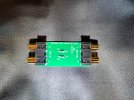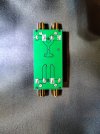Hey, MCH. Me neither, but it gives me peace of mind knowing that better components are used. If it sounds good that's all I need. But we cannot also forget that good measurements are like marketing and publicity nowdays. It might be the placebo effect or not, but people feel happier if their believes are validated with numbers.
I'm not going to say that everybody, but for example many people could felt happy with their gear before, until that same gear is measured here, and measured poorly or not as good as they expected. Suddenly that gear does not sound as good as before anymore.
I completely agree with you that if an amplifier is publicized to work with a 48V PS, should have components able to safely handle that voltage, and not running right at the limit. Most of the time people only think about capacitors rated voltage, but there are other components which are sensitive to that higher voltage. I'm talking about the voltage regulator. The voltage regulators bring down the voltage by "burning" the excessive voltage. This causes the regulators to heat up. The more voltage the regulator needs to "burn" the more heat it produces and its internal temperature rises. This is why I don't agree on using 48V power supplies on these type of amplifiers.
Being honest, why do people need to use a 48V power supply? Is their required output voltage swing to be that high?
A 48V DC signal can handle up to a 48V AC peak(not RMS, not peak-peak) signal. This means it can handle (without clipping) 0.707x48V=33.93VAC rms. That will require an input signal of 33.93V/28.18 (gain equivalent to 29dB)=1.2Vrms of audio signal (not test tones at 0dBFS). Real music plays in "average" -12dBFS (or 4 times lower voltage that what the DAC normally can produce. This means we need a single ended DAC with a 4.8V rms at (0dBFS) output to produce a 1.2V rms musical signal at -12dBFS, do we have those DACS?). All this translates into a 143.95W/ch (this is beyond the amplifier capacity for a clean signal) at 8ohms, and requires a 6A 48V Power supply (assuming an ideal amplifier with no extra power used for any extra functions, and not having any losses). Is that really the amount of power we need or use? Just because we use a higher voltage power supply it does not mean the amp will deliver more power. If we don't increase the input signal then the amp will not take advantage of that higher output voltage swing. The input signal (audio signal and potentiometer position) is what determines the output signal. If the amplifier voltage is not high enough to handle that output signal then the amplifier clips. It's only in this case where a bigger power supply shows a benefits. If the output AC signal is only 5V (5*5/8ohm or 3.125W), then there is no benefit on having a 48V PS.
Let's do a real life example. We have a DAC capable of outing 2V rms at 0dBFS, this means 0.5V rms of real music at the amplifier input with the potentiometer at max. 0.5Vrms x 28.18 gain = 14.09VACrms output signal. Because this is AC it needs a DC carrier higher than the peaks of the AC signal, otherway it clips the signal. So 14.09/0.707=19.92V peak. So we only need a 20V DC power supply to take advantage of all the musical signal we can provide with that DAC. I know people will say hey Mick but what happen with those cannons of whatever symphony and explosions or those massive peaks or whatever? Ok, the A07 Max comes with a 36V DC rms power supply. This allows up to 25.45AC rms output swings, which therefore allows up to 0.903Vrms of input signal before clipping, this is an extra 5.1dB headroom compared to the 0.5Vrms before. All this assuming we are maxing up the potentiometer (I really doubt we are maxim up the amplifier power in first place). Does anybody remember the PMPO vs RMS power discussions from years ago? those inflated values compared to the RMS ones. This is exactly what happens with those peaks which occur during 0.5 seconds or so. The amplifier can deliver 10 times more power during those short moments. So no need to worry about.
Most of the people use (knowing or unknowing) a 0.5V input signal (from a 2V 0dBFS DAC), but then use the potentiometer at 12 o' clock. Depending on the pot type (Linear or Log) this means a completely different input signal right at the chip inputs, way lower than the DAC output signal. For example, I'm going to talk about my personal case. In average my output signal is no more than 2V at the speaker terminals. This means 0.5W with 8ohms nominal speakers. This allows me to play music at 85dB from 1meter or so. This is more than enough for me. This means that if 2V AC rms is the output, then the input signal at the chip is 2V/28.18= 0.0709V. That is nothing compared to the 0.5V signal coming out of the DAC. This is the effect of the pot. This is 7 times lower voltage or 14% of the input signal. The potentiometer position is at 12 o' clock.
I know every case is different. Maybe you have low sensitivity speakers(85dB vs 88dB needs twice the power, 1W instead of 0.5W), maybe your listening distance is longer (6dB drops everytime you double the distance. 2m vs 1m requires 4 times for power. Now, again 4W instead of 1W). So 4W/ch is all you need under these new conditions.
Are we maxing up the potentiometer? if so, maybe all we need is a higher input signal. I'm an advocate of using a preamp to increase your input signal instead of a bigger and higher voltage power supply. If not, maybe all we need is to increase the pot a little more. Don't be afraid to increase it beyond 12 o' clock (this is where all the juice is squeezed) 12 o'clock is just 10-15% of the input signal on these Log Pots.



